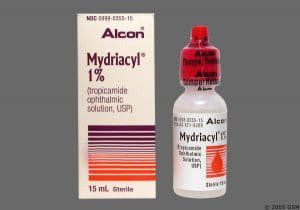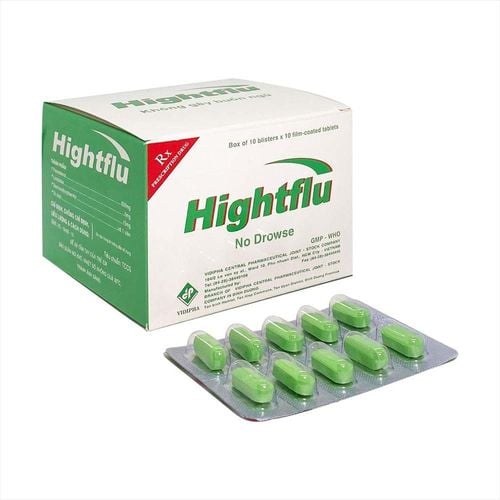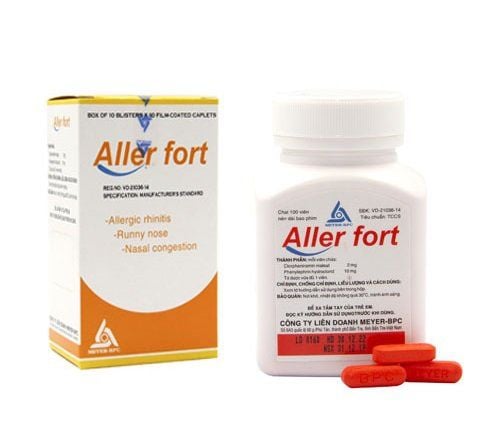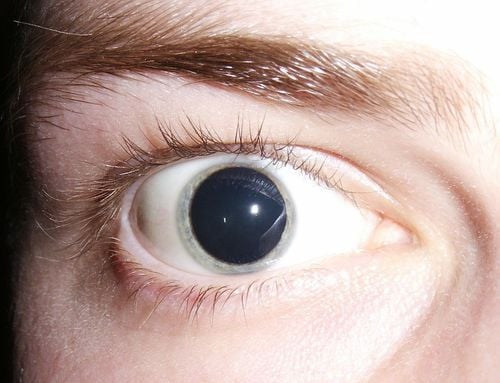This is an automatically translated article.
Phenylephrine hydrochloride is a sympathomimetic that acts directly on a1-adrenergic receptors that constrict blood vessels and increase blood pressure. It has a weaker effect on blood pressure than norepinephrine, but has a longer duration of action. To ensure the effectiveness of treatment, patients need to take the drug according to the instructions of the doctor, professional pharmacist.1. What is Phenylephrine?
What is Phenylephrine or what is Phenylephrine hcl? This is a question that many people ask. Phenylephrine hcl or Phenylephrine hydrochloride is a sympathomimetic, which acts directly on a1-adrenergic receptors that constrict blood vessels and increase blood pressure. It has a weaker effect on blood pressure than norepinephrine, but has a longer duration of action. Phenylephrine hydrochloride can cause reflex bradycardia, decrease blood volume in the circulation, decrease blood flow through the kidneys, and reduce blood flow to many tissues and organs of the body. Phenylephrine also has an indirect effect by releasing norepinephrine from the reservoir into the circulation. As a result, some people notice signs of getting used to the drug, reducing its effectiveness in subsequent treatments. Some therapeutic applications of Phenylephrine:
Phenylephrine can be administered systemically. In the past, it has been used to treat shock after giving enough fluids to help raise blood pressure, but its effectiveness has not been proven and may increase the risk of harm to the patient. In this case, drugs Norepinephrine, metaraminol are often preferred, especially when it is necessary to stimulate myocardial activity, especially in shock due to myocardial infarction, sepsis, surgical complications. However, phenylephrine may be useful in the treatment of hypotension caused by anesthesia with drugs such as cyclopropan, halothan, or other drugs known to induce arrhythmias. Phenylephrine has also been used to prevent and treat hypotension due to spinal anesthesia, but is controversial because it can reduce cardiac output. Using phenylephrine to treat hypotension during anesthesia for pregnant women is still controversial, because it may not be necessary but only treatment with adequate fluid replacement and changing the patient's position so that the uterus does not press on. inferior vena cava. If medication is needed to raise blood pressure, ephedrine is usually preferred. Phenylephrine has also been used to treat paroxysmal supraventricular tachycardia, especially when the patient is hypotensive or in shock, but may be resistant to another drug. Today, the drug is mainly used topically or in combination to treat eye disease or nasal congestion. Phenylephrine is prepared in many different forms including: injection, tablet, oral solution, suppository, cream, gel and 0.25% ointment, eye drops, nasal solution.
2. Indications and contraindications of Phenylephrine
Phenylephrine is indicated in the following cases:
Systemic: Currently, this drug is rarely indicated for systemic effects. Indicated for oral use alone or in combination for the treatment of nasal congestion. Indications for topical use: Eye drops to help dilate the pupils in the treatment of adhesions uveitis; preparation for pupil dilation before eyeball surgery; used for diagnosis through ophthalmoscopy; Eye drops to relieve conjunctival congestion in acute conjunctivitis; Drop the nose to help relieve nasal congestion, reduce swelling of the nose and sinuses due to colds... Contraindications of Phenylephrine:
Patients with severe cardiovascular disease, myocardial infarction, coronary artery disease. Hypertension, atrioventricular block disease, severe arteriosclerosis, ventricular tachycardia. Severe hyperthyroidism or closed-angle glaucoma. The 10% solution is not recommended for children or the elderly. Do not use 10% and 2.5% solutions for infants born with low birth weight. To avoid complications due to the risk of hypertension in children, for eye drops only 0.5% eye drops should be used. Not recommended for use in children under 1 year of age. Do not use in patients with a history of hypersensitivity to the drug, cross-sensitivity to pseudoephedrine or hypersensitivity to other components of the drug. Do not take oral drugs with MAO inhibitors or have stopped taking MAO inhibitors for less than 14 days and pregnant women in the first 3 months.
3. Dosage and usage of Phenylephrine
How to use: Depending on the form of protection, there are different ways to use it.
Dosage:
For adults
Systemic use: The lowest effective dose should be used and for the shortest possible time.
Hypotension: Initial dose 2 - 5 mg subcutaneously or intramuscularly; The following dose ranges from 1 to 10 mg if needed depending on the individual response. 100 - 500 micrograms can be given slowly intravenously, then repeated if necessary after at least 15 minutes; In case of severe hypotension, dissolve 1 ampoule of 10 mg in 500 ml of 5% glucose solution or 0.9% sodium chloride intravenous infusion at an initial rate of up to 180 micrograms/min, and then gradually decrease according to response to 30 - 60 micrograms/minute; Prophylaxis of hypotension during spinal anesthesia 2–3 mg subcutaneously or intramuscularly 3–4 minutes prior to spinal anesthesia. Emergency treatment of hypotension during spinal anesthesia in adults: Intravenous, initial dose 0.2 mg; then inject with a dose that should not exceed the previous dose of 0.1 - 0.2 mg. Paroxysmal supraventricular tachycardia: A dose of 0.25-0.5 mg IV is usually given over 20-30 seconds. Treatment of nasal congestion: Used orally to treat nasal congestion with a dose of about 10 mg / time, every 4 hours, 1 time, up to a day not to exceed 60 mg. Eye drops:
For pupil dilation and vasoconstriction, instill 1 drop of 2.5% solution or 10% solution into the conjunctiva, repeat 1 hour later if necessary; For prolonged pupil dilation, drop 1 drop of 2.5% solution or use 10% solution about 2-3 times per day; Treatment of conjunctivitis (pink eye) put 1 drop of 0.12% phenynephrine solution into the conjunctiva, every 3-4 hours as needed; To cause pupil dilation before surgery, 1 drop of 2.5% or 10% solution should be put into the conjunctiva about 30 - 60 minutes before surgery; Eye drops cause pupil dilation for diagnosis:
Measure eye refraction and put 1 drop of blepharospasm drug into the conjunctiva, then 5 minutes later, drop 1 drop of 2.5% phenylephrine solution; For ophthalmoscopy, put 1 or 2 drops of 2.5% solution into the conjunctiva, about 15 to 30 minutes before ophthalmoscopy, can be repeated after about 10-60 minutes if needed; Retinoscopy requires instillation of about 1 drop of 2.5% solution into the conjunctiva. Nasal drops: Instill 2 - 3 drops or use a nebulizer with a solution of 0.25 - 0.5% in each nostril, about every 4 hours if needed. If the nasal congestion is much, the first time can use 1% solution.
Dosage for children:
Systemic use: Treatment of hypotension in spinal anesthesia using the recommended dose of 0.044 - 0.088 mg/kg by intramuscular or subcutaneous injection.
Eye drops:
Mydriasis: Instill 1 drop of 2.5% solution into the conjunctiva, repeat 1 hour later if necessary. Prolonged pupil dilation: Instill 1 drop of 2.5% solution into the conjunctiva and instill 2-3 times a day. Pupil dilation before surgery: Instill 1 drop of 2.5% solution into the conjunctiva, 30 to 60 minutes before surgery. Dilating the pupil to make a diagnosis:
Refractometry: Instill 1 drop of atropine 1% solution into the conjunctiva, then in 10-15 minutes add 1 drop of 2.5% phenylephrine solution and continue to instill 1 drop second solution of atropine 1% after 5-10 minutes. Ophthalmoscopy: The dose is the same as for adults. Nasal drops: To help relieve nasal congestion
Children under 2 years of age: The dose is prescribed by the doctor, depending on the patient. Children from 2 to 6 years old: Put 2 - 3 drops of 0.125% - 0.16% solution in each nostril, every 4 hours if needed. Children from 6 to 12 years old: Instill 2-3 drops in each nostril or use a mist of 0.25% solution, every 4 hours if needed. 0.5% phenylephrine solution should not be used for nasal drops in children under 12 years of age. 12 years and older: Take the same dose as adults.
4. Possible side effects when taking Phenylephrine
Some possible side effects when taking Phenylephrine include:
Common side effects: Agitation, restlessness, anxiety, trouble sleeping, fatigue, dizziness, chest pain, tremor, paresthesia of the extremities , increased blood pressure, pale skin, skin cold feeling, local irritation when used topically. Uncommon side effects: Hypertension may be associated with pulmonary edema, cardiac arrhythmias, bradycardia, peripheral and visceral vasoconstriction causing hypoperfusion to these organs, respiratory depression, euphoria, hallucinations, paranoia, if the drug is injected outside the vessels, it can cause necrosis or desquamation, release pigment granules in the iris, can blur the cornea. Rarely causes myocarditis, subpericardial hemorrhage.
5. Some things to keep in mind when using Phenylephrine
If you have had an allergic reaction to a drug in the past, tell your doctor. Avoid using when known to have an allergy to the drug. It is necessary to replenish the body with sufficient fluid before taking phenylephrine. Either central venous pressure or left ventricular blood pressure must be monitored so that hypovolemia can be detected and treated; In the preparation of phenylephrine hydrochloride injection, to prevent oxidation, people often add sodium metabisulfite, which is a substance capable of causing allergic reactions, especially in people with allergic conditions such as asthma. It should be used with caution in special populations such as the elderly, patients with hyperthyroidism, bradycardia, partial heart block, severe arteriosclerosis, type 1 diabetes, cardiomyopathy. Care should be taken when administering the drug orally in patients with bronchial asthma, intestinal obstruction, and benign prostatic hypertrophy. When using the drug, if you see any symptoms of irritation, dizziness, sleep disturbance, you must stop the drug and immediately notify the medical staff. For pregnant and lactating women, there is no evidence that the drug is safe to use. Should not be used unless absolutely necessary. If accidentally overdose of phenylephrine causes hypertension, headache, convulsions, risk of cerebral hemorrhage due to hypertension, palpitations, extrasystoles, paresthesias. When an overdose is detected, drugs should be used to treat symptoms and support general medical care. Drug interactions can occur when this drug is used concurrently with certain other drugs. Drug interactions will increase the risk of side effects and limit the effects of the drug. Some drugs that may interact with this drug include: Adrenergic system alpha and beta blockers, Oxytocin, do not combine this drug with sympathomimetics, interact with other drugs such as digitalis, diuretics, antidepressants depression. Some drugs are incompatible with Phenylephrine iron salts, metals. For topical small forms, care should be taken to avoid contamination of the face drops or nose drops. Above is some information about the drug phenylephrine. Patients need to take the drug under the direction and monitoring of the doctor, if there is an abnormal problem when taking the drug, you should notify it for timely advice and treatment.
Follow Vinmec International General Hospital website to get more health, nutrition and beauty information to protect the health of yourself and your loved ones in your family.
Please dial HOTLINE for more information or register for an appointment HERE. Download MyVinmec app to make appointments faster and to manage your bookings easily.













